Presidents: Harry S Truman
Harry S Truman Birthplace State Historic Site, Lamar, Missouri
Visited in 2010.
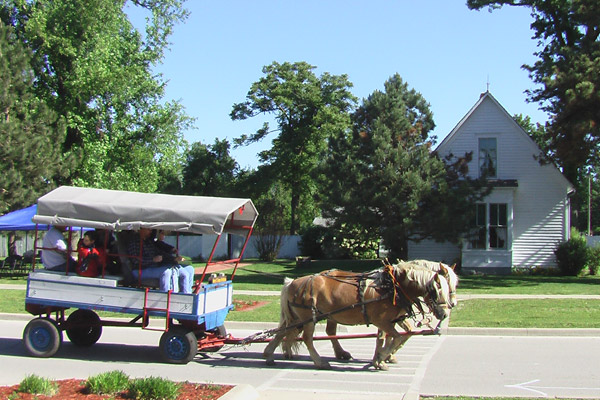
The sleepy town of Lamar, on Truman's birthday 2010.
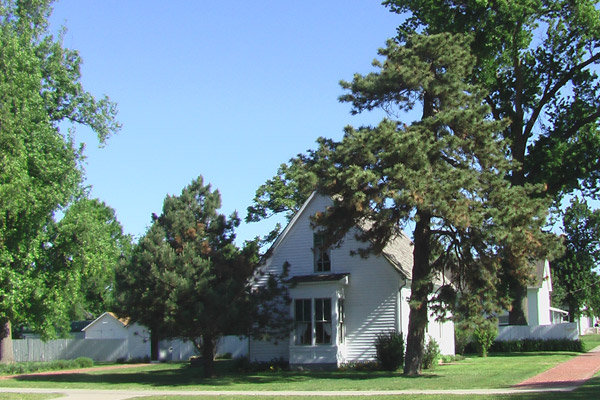
Truman: A modest guy born in a modest home.
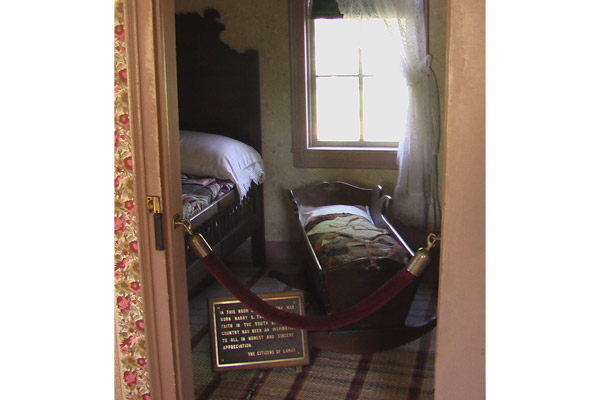
Next on MTV's "Cribs": Harry Truman.
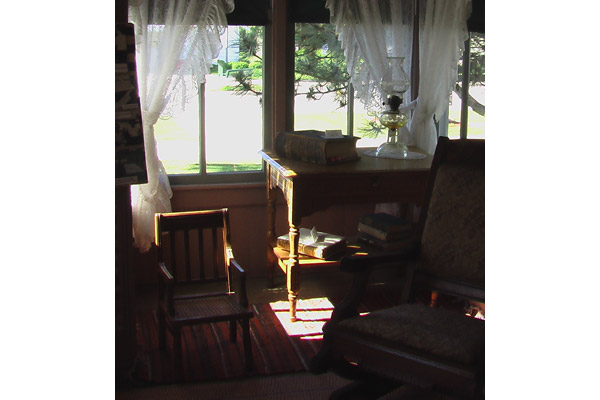
Another shot of the middle-class birthplace.
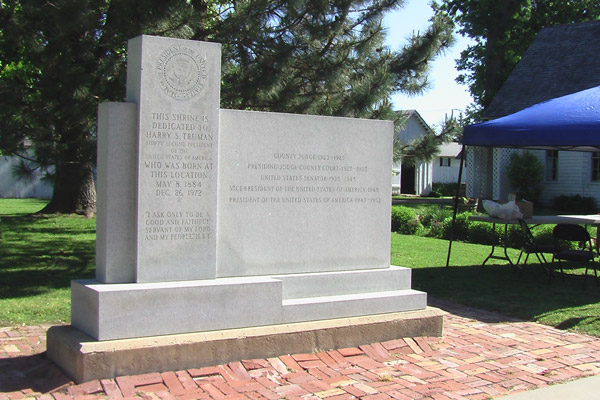
Labor unions ponied up for this nice stone marker on the site.
On May 8, 1884, Harry Truman came into the world. On May 8, 2010, I went to Lamar, Missouri, to see the spot where it happened. And there wasn't a historical re-enactment or anything. Way to drop the ball, Lamar.
There's not a ton to the Truman birthplace. Lamar, in southwestern Missouri, was a cow town. Truman's dad was working with livestock in some capacity. He bought the house for the whopping sum of $685 in 1880. It didn't have electricity or plumbing, it was right near the train tracks, and the lot across the street was swarming with animals of many kinds. The home consisted of a few tiny downstairs rooms and a few tiny upstairs rooms. The furnishing was very plain, and you can "tour" the whole building in about 35 seconds. The Trumans left town when Harry was 11 months old and headed north to farm near Kansas City.
Basically, Lamar was a non-factor in Truman's life. The good people there weren't bristling with exciting stories about Harry learning the true meaning of international relations through a run-in with an rabid steer. There was no tragic butter churning accident that killed a sibling and kept our future 33rd president from ever knowing the true meaning of love. If Harry tamed a horse using nothing more than a baby rattle and a surprisingly firm grip ... well, the guide left that story out.
But you can take it for what it is: a sampler of circumstances. Truman's family trade was agriculture. He identified as a farmer, so there has to be some value in seeing his roots up close, right? Plus, if you visit the town, you can drive around Lamar's cute town square, and stop at the same convenience store where I bought Pop Tarts for breakfast -- the exact same kind of Pop Tarts that John Anderson Truman would have hand-fed his baby boy in the late 19th century.
Actually, on further reflection it's kind of cool that the birth house still exists. Apparently the United Auto Workers bought the place and gave it to Missouri in 1959, as a way to thank Truman for all his good work on behalf of lazy people over the years. HAH! Truman himself came down from Independence for the dedication ceremony, but after that visit he never returned to the hallowed ground where, in 1884, he sprang from his father's temple wearing an impeccable suit and hat.
Independence and Kansas City, Missouri
Visited in 2010.
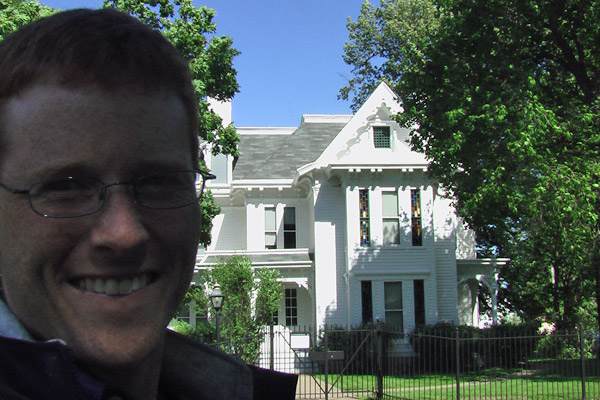
Delaware County visits Delaware Ave.
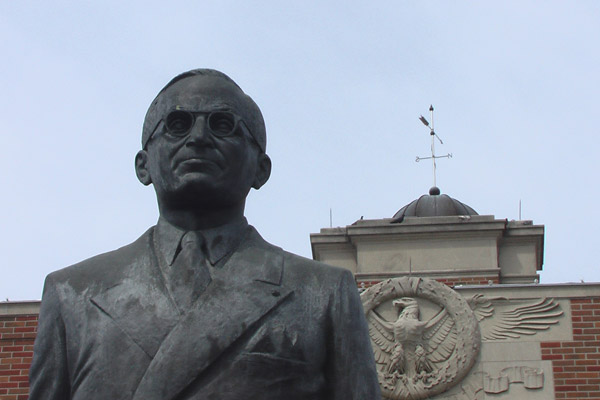
The Truman statue outside the Jackson County courthouse.
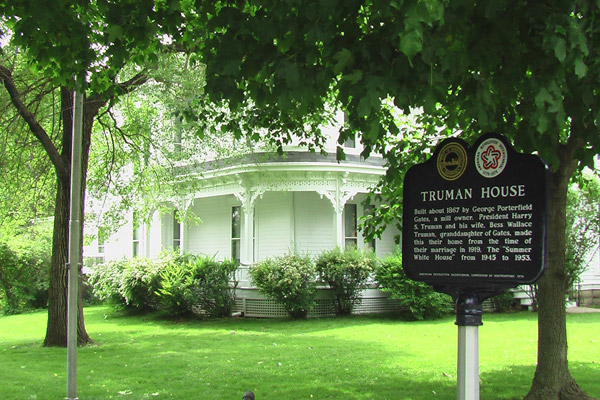
This sign is just wild about Harry.
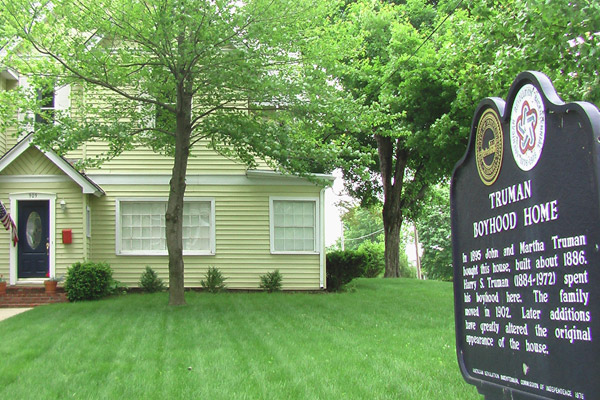
A stroll around downtown Independence takes you to LOTS of Truman sites.
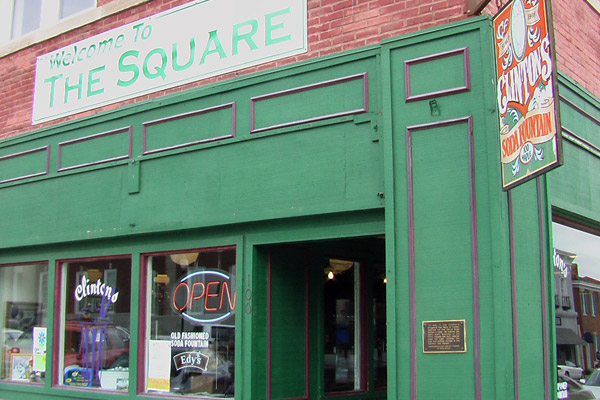
What a jerk! The soda fountain where Truman worked as a kid.
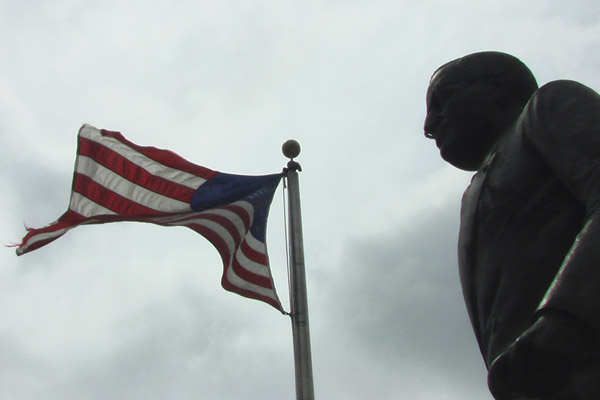
Another view of the statue outside the courthouse. AMERICA!
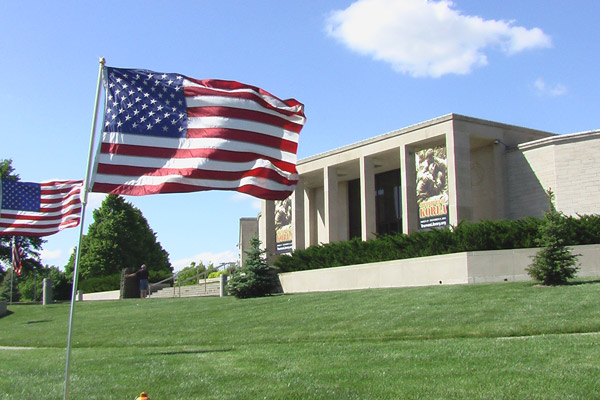
Truman's final project: The library and museum just blocks from his home.
At age 33, Harry Truman considered himself a failure. Twenty-eight years later, he was reordering the human condition -- he had the final say on actions with no precedent, that no man has dared use since.
All this makes the town of Independence, Mo., amazingly intriguing. The man who started the atomic age -- who defined the Cold War and led America into an age of global dominance -- thought of himself as a small-town hick. Truman was supposedly defined by simple Midwestern values. And those values guided him through the end of World War II, the start of the Cold War, the creation of Israel and mounting racial tension.
It makes you want to see the town. And you can! Truman himself admitted that Independence had changed beyond recognition -- it grew from 6,000 people to 100,000 in his lifetime -- but he never soured on his home. He lived there for 20 years after departing the White House, building his library, shaking hands and dishing out street justice. Harry Truman was the Archie of his personal Riverdale -- only in this case, Archie got old, finally settled on one babe and eventually died.
Truman's story arc is great. His family -- a bunch of farmers at heart -- moved to Independence when he was very young. They changed homes every few years, as economic circumstance warranted. (Truman's dad was a crappy investor, a distinction which Harry apparently inherited.) Truman supposedly spotted his future wife at Sunday school when he was 6, and was smitten with her even then. They graduated high school together, though they were not an item. He tried to get his career off the ground by working as a banker in Kansas City, but due to family emergencies he was drafted into service on the family farm in Grandview, a little bit south.
Truman was a hard-working farmer, but living in Grandview he had very little in the way of savings, career prospects or romantic prospects. Therefore, when America entered World War I, Truman was thrilled to sign up. (When the potential of trench warfare and getting mustard gassed looks appealing, that's saying something.) Truman became the captain of an artillery brigade and proved to be a fine leader.
And his success as an officer spilled over into his love life. After years of courtship and a few rejections, Bess Wallace finally agreed to marry Harry on his return from the war. She had some money and a huge house, which are wonderful things to have in a wife. Truman's turnaround was completed as he opened a haberdashery in downtown Kansas City.
It was a colossal failure.
That's what makes Truman fascinating. He kept getting kicked in the teeth, but he kept on plugging. He bought oil wells which crapped out. His clothing store was such a mess that he was paying off the debts for a decade. He wanted to be a concert pianist or a white-collar professional, but instead he swallowed his dreams to help out on the farm. In school, he sucked at sports and ended up burying his nose in books. Harry Truman is relatable to anyone who's ever had a crappy setback. And everyone has had a crappy setback.
In that vein, Truman's start in politics wasn't particularly glorious. He needed a job, and Tom Pendergast selected him as his puppet for Jackson County Judge. (That's essentially a fancy term for county administrator.) Pendergast was the scumbag who ran Kansas City's Democratic political machine. Truman was a good administrator, but he had to play the game. He handed out jobs to cronies and that sort of thing. It made him feel slimy. Pendergast allegedly got tired of Truman being too upright -- so he moved him out of Kansas City by arranging his nomination for a U.S. Senate election. Once elected, Truman was shunned by colleagues as the "Senator from Pendergast."
Pendergast eventually did Truman a solid, by getting indicted and convicted for income tax evasion in the early 1940s. And when Truman was free to make a name for himself, he finally started getting the breaks. He became an national political star by investigating fraud in military contracting. Thanks to the byzantine power dynamics of the FDR administration, Truman's performance (and his status as a well-liked and now inoffensive Democrat) earned him the VP nomination in 1944.
FDR then did Truman a solid, by dying. Suddenly, a small-town hick was in charge during one of the most turbulent periods in U.S. history. He had to finish the war, establish a new world order, transition America back to a civilian economy and (on the cultural end) deal with the transformation of traditional gender roles and race relations.
There are a few ways to absorb the Truman story when you visit Independence. I vote for the walking tour of the town. Truman himself was an avid fan of walks, usually snapping off a two-miler around town every morning that his schedule allowed. (Truman always seemed to dress pretty smartly, however, whereas you will probably be in a track suit or some kind of T-Shirt from Senor Frog's.) As much as Independence has grown, a lot of Truman's neighborhood still has the same character. You'll pass the homes of all his old friends, the site of his high school, the meeting hall where he voted, the church where he got married and the courthouse where he had his offices as Judge. A few of Truman's boyhood homes are just a few blocks from the Delaware Ave. house where he moved in with Bess. I had a mango-peach smoothie at Clinton's, the soda fountain where Truman landed his first job around 1898. He got $3 to sweep the floors and be a soda jerk as needed. I don't know that Truman ever had to work a smoothie machine, but I'm sure he would have done a hell of a job.
I can't tell you about the Delaware Ave. house, because at the time of my visit they were busy reinforcing the Masonic enchantments on the Demongate in the basement. Or, as they put it, "putting in central air." The house is big, but that's more a reflection of the former wealth of Bess' family, and not Harry's wild success. Truman wasn't flush with cash -- he actually took a lot of crap for putting Bess on the Senate payroll to answer his mail. But he had to employ his wife to pay his family's bills. Leaving office in 1953, Truman didn't have much more than his military pension and some modest savings.
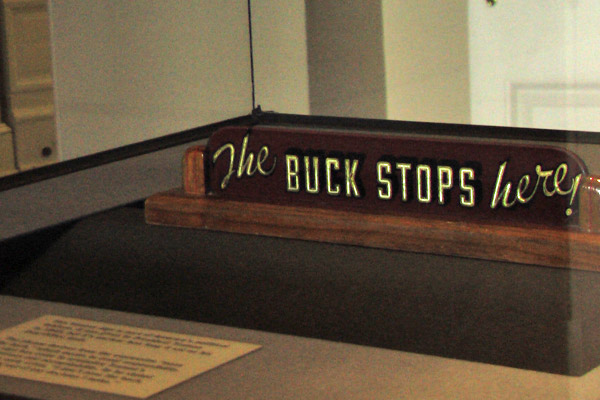
Perhaps the greatest knicknack in presidential history.
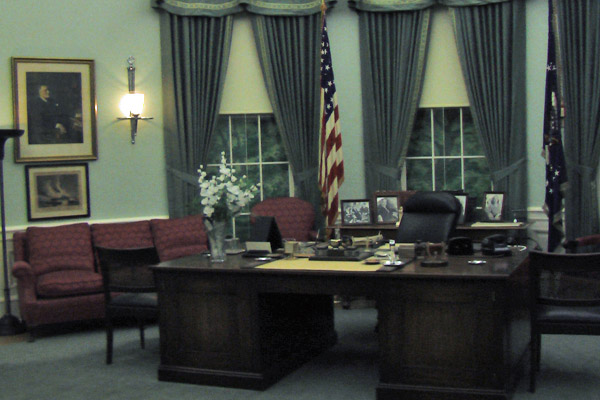
In the museum, the replica of Truman's Oval Office.
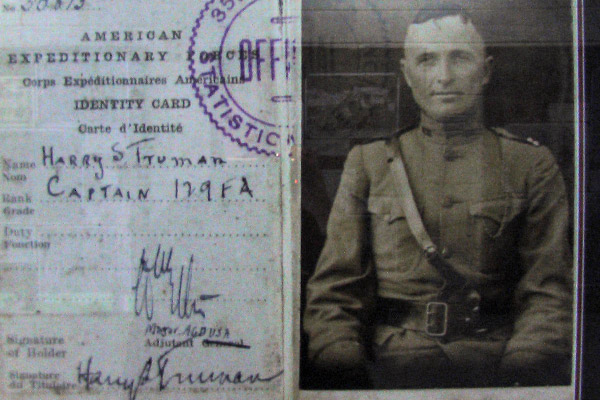
Truman's WWI credentials, on display in the museum.
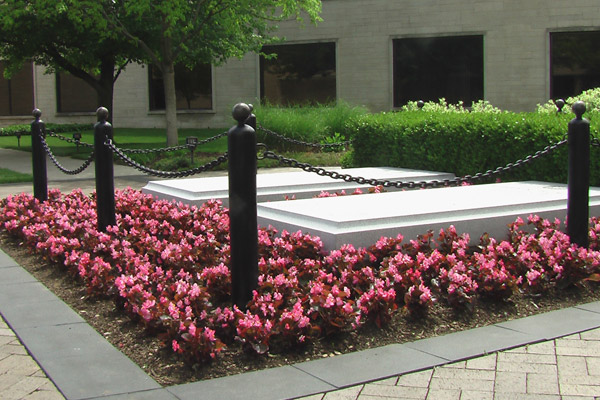
Harry and Bess, at rest in the museum's courtyard.
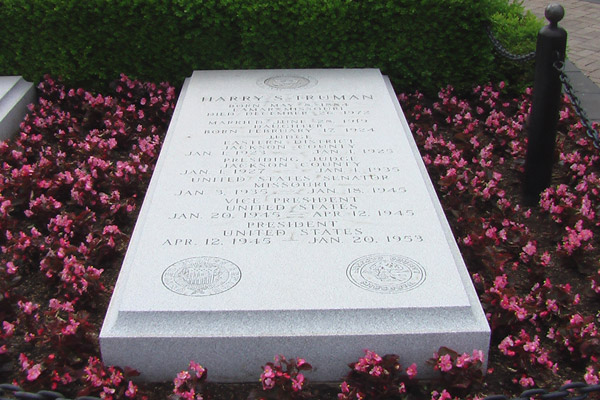
Truman's grave marker. He liked to read, which might explain the huge epitaph.
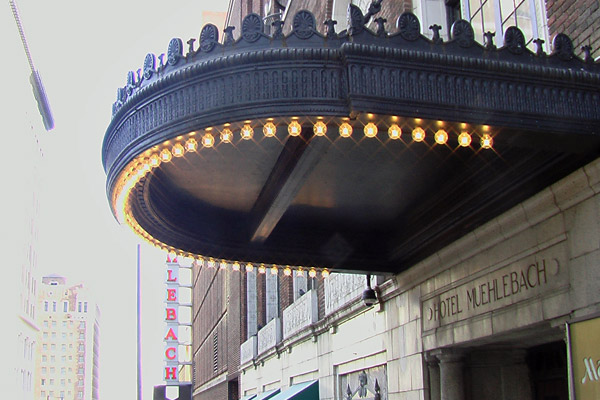
In downtown Kansas City, the hotel where President Truman kept his "home offices."
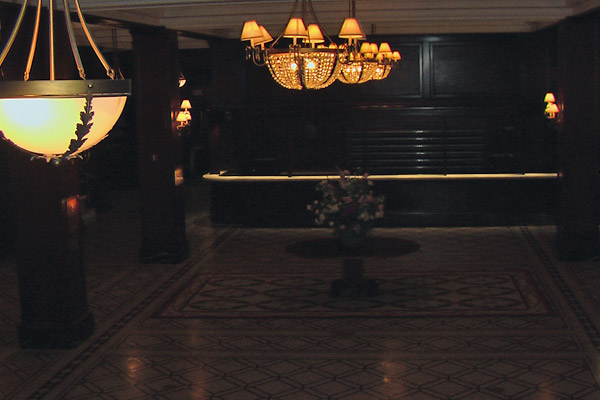
The lobby of the Muehlebach Hotel.
What he did have was the street cred to drum up funding for his presidential library, just down the street from his home. I gotta say I liked it. Similar to the Ford museum in Grand Rapids, the museum portion tries to give you a snapshot of the era, not just a laundry list of reasons Harry Truman is awesome (which he sort of is). There are some very good displays highlighting the differences of opinion over the atomic bomb and Korea. It's reading-heavy, as they often use Truman's personal letters or memos to illustrate a point. But when you see how blunt and straightforward he was in his correspondence, how he sized up the players he was dealing with, you do get a better idea of the guy making all these worldbending decisions. Some notes to Truman are kind of thrilling -- Eisenhower reporting in from his first weeks at the newly minted NATO -- while others, like a 7-year-old girl begging Harry to rehire Douglas MacArthur to whup up on the Chinese, are kind of heartbreaking.
Artifact-wise, the museum has some stunners, such the guns used by the Puerto Rican nationalists who tried to kill President Truman. There also an original copy of the "Dewey Defeats Truman" newspaper. There's some cute stuff -- an invitation to the 1948 inauguration in which Harry scrawls that he hopes to attend, weather permitting. His personal office in the library is cool to see, as is the replica of his White House oval office. "The Buck Stops Here" sign has a pedestal of its own.
But the highlight is Harry himself, resting in a courtyard with Bess and their daughter. Their graves are marked with nice, simple slabs in the middle of a pleasant flower bed. It's not flashy, because Truman wanted it that way. The tombstone does answer a mildly legendary copy editing riddle, about the "S" in Harry S. Truman. The president insisted that his middle initial stood for nothing, as he had grandparents on both sides with "S" names. By sticking to the single initial, he avoided pissing off either side. As a result, generations of journalists have been mystified as to whether or not to include a period after the S.
There's a period on his tombstone, so that's what I'm going with from now on. Etched in stone is good enough for me.
The whole experience was spiffy, not unlike one of Truman's double-breasted suits. I get the impression that Truman's politics weren't necessarily philosophical. Instead, they were grounded in his upbringing. He came up with a lot a hard-working, regular people, he lived through a time when a lot of those people couldn't seem to catch a break, and so be believed that those people would be responsible if government gave them a leg up. Modern thinking about "entitlements" has been poisoned by 60 years of mixed results. In his day, Truman was willing to keep up the New Deal and push for health care, housing, and other benefits -- because it all made sense in the context of Independence. He saw a lot of the globe, but small-town Missouri was the lens through which he viewed the world. You might not agree with Harry Truman, but it's very hard not to respect the hell out of him.
Truman Little White House, Key West, Florida
Visited in 2011.
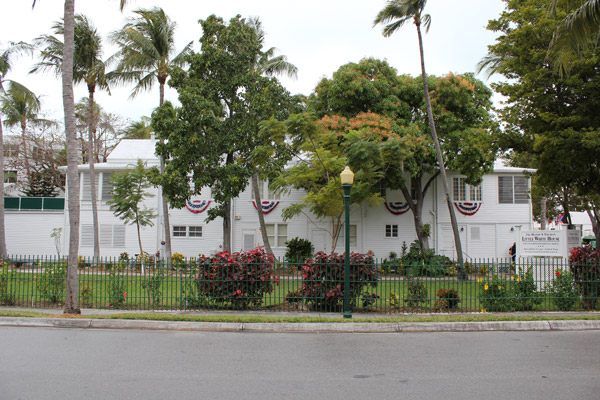
The approach to Truman's favorite vacation home.
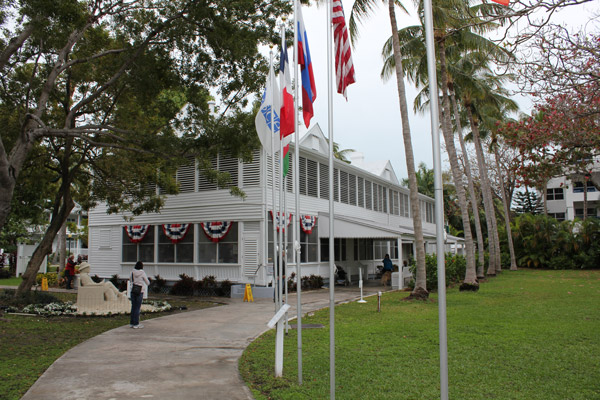
Nothing fancy -- which is how Truman liked it.
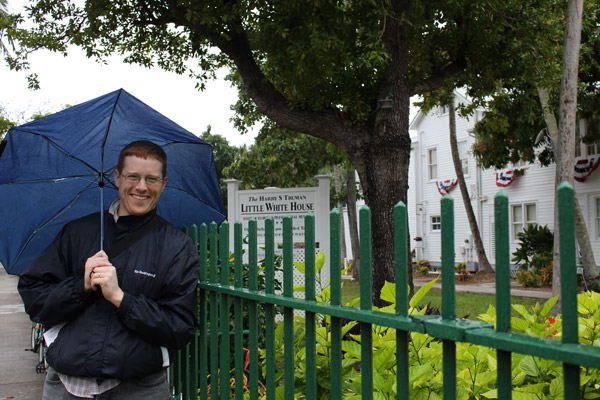
No pictures allowed inside so here's me by a fence. You're welcome.
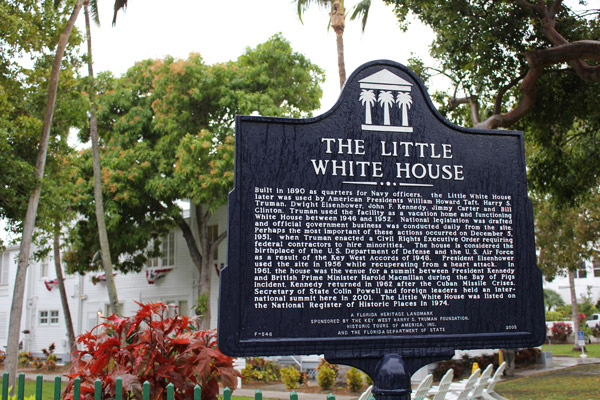
Some background info for anyone into fine print.
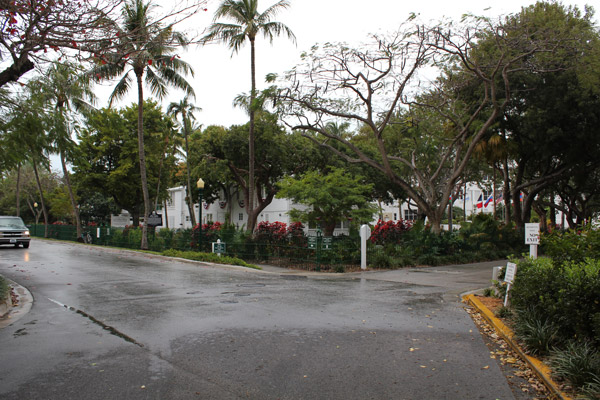
We didn't visit on the nicest day in the history of Key West.
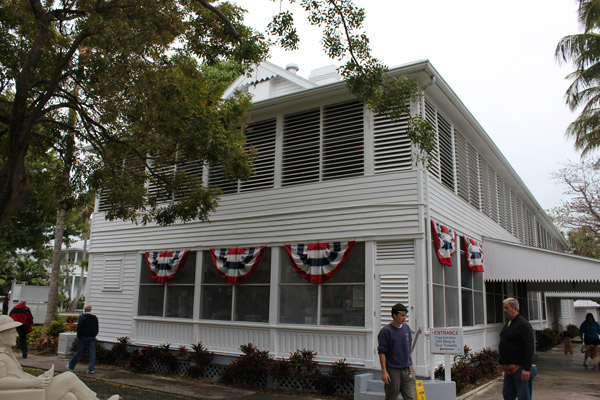
The bunting makes it extra presidential.
After a hard day of managing the nuclear terror you unleashed on the world, a man needs to unwind. Fortunately Harry Truman had the facilities of the U.S. government at his disposal, and the Navy puts bases in all the sexiest party spots. The old commandant's house in Key West was sunny, spacious, and just blocks away from the same bars where Ernest Hemingway had barfed. A terse, elegant, hard-nosed barfing, but barfing nonetheless!
Truman first went to Key West on doctor's orders, and was enchanted. He didn't get to take in many of the drag shows, nor did he care much for fishing, or wandering the streets in a drunken haze. But he did have lovely weather and a big honking house to pad around in. There was a nice bar, a poker table to entertain all his buddies, and access to a secure beach where he could work on that "all-over tan." (There have photos of a shirtless Truman, and despite supreme cardiovascular fitness, let's just say he didn't have an Obama body.)
The "Little White House" was relaxing enough that he ended up spending about half a year there over the course of his presidency. That's more time than he spent in the actual White House, which was under renovation as they took out all the FDR ramps. The building was orginally a duplex, but a particularly reproductive base commander converted it into a single residence to accommodate his 14 children. That left Harry with a ton of floor space and a swank wrap-around porch. His piano is still in the living room and his desk is sitting upstairs. And best of all, there are separate bedrooms! Harry was usually in Key West without Bess, but on those few occasions when you're on vacation with your wife, nothing harshes a buzz like having to sleep with her.
Truman wasn't the only POTUS to enjoy the accommodations. Eisenhower spent some time there recovering from one of his annual heart attacks, JFK conducted some diplomatic maneuvers on the lawn, and the Clintons even crashed there for a weekend even though it stopped being a government facility in the 1970s. The building probably isn't too high on the historical significance scale, but a few things are certain: Truman really put Key West on the map as a tourist destination, and the house really matches the whole Truman ethic. He was a simple midwestern guy, and his vacation time was charmingly ordinary -- poker, beach-bumming and really tacky shirts. He walked the walk.
FUN LITTLE WHITE HOUSE FACTS!
- Truman referred to the loud shirts at the Key West "uniform" and changed into one as soon as all of the formal ceremony of his arrival was done with. Starting in 1950, he enforced a strict "no shirt, no shoes, no Communists" policy.
- There's a rooster motif to some of the knicknacks in the house, as the rooster was an old symbol of the Democratic Party. You know, before they got rid of that stupid mascot and chose something more dignified, like a donkey.
- The ashtrays built into the poker table were made from discarded naval shell casings. All guests also drank beer from goblets fashioned from the skulls of America's enemies.
- The presidential yacht docked nearby to serve as a kitchen, communications center and make-out room for any Cabinet member who got lucky on Duval Street.
The Ferdinand Magellan: Presidential Rail Car, 1943-1958
Visited in 2021.
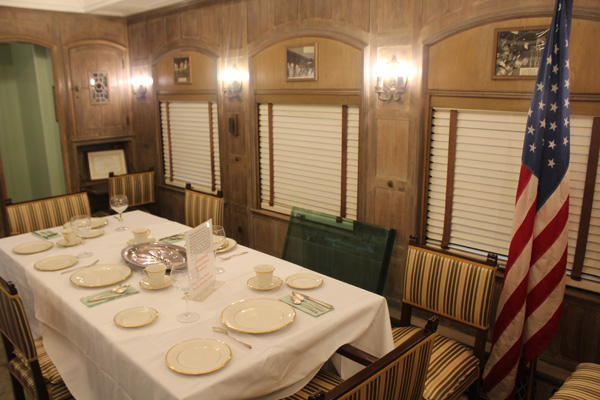
Fine dining at 35 mph. The dining car!
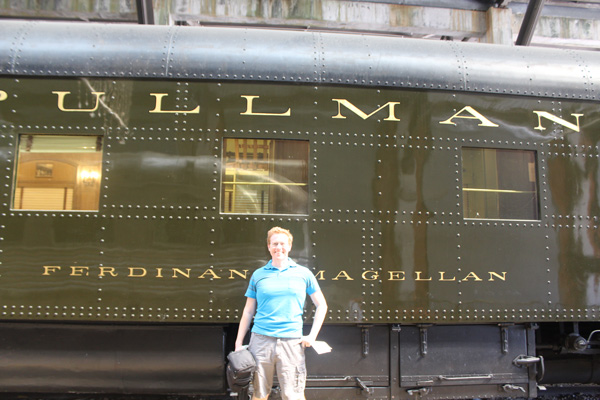
Checking out the armor plating (on the train, not my cargo shorts)
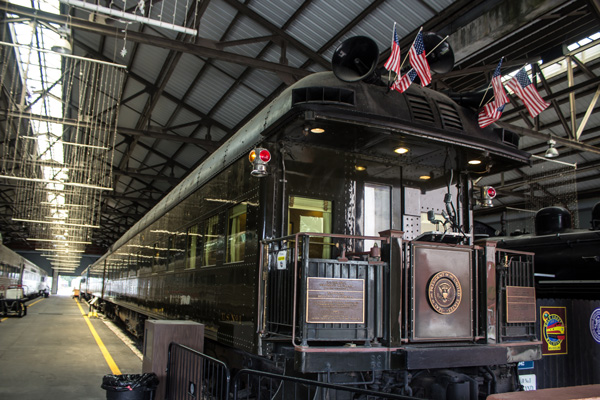
End of the line! The platform where Truman took his victory lap
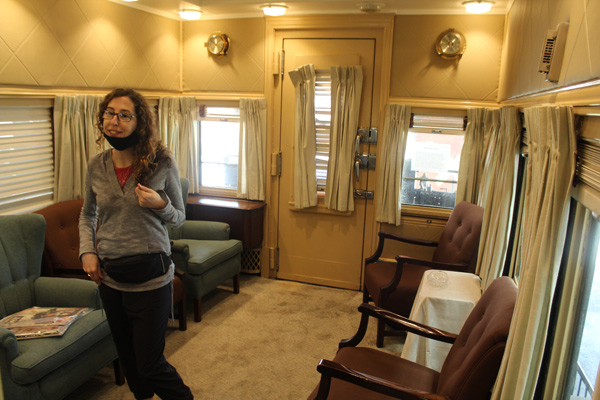
The lounge at the back of the president's rolling rumpus room.
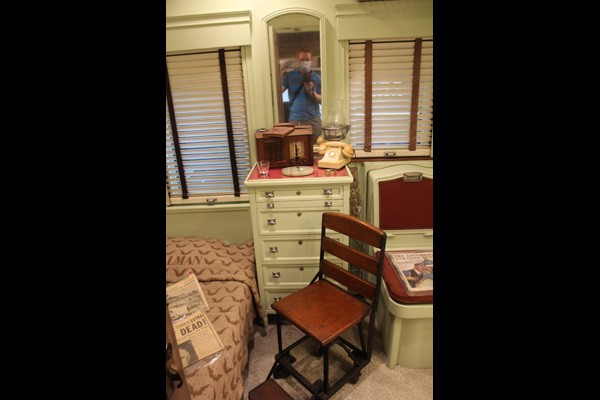
FDR's special accomodations.
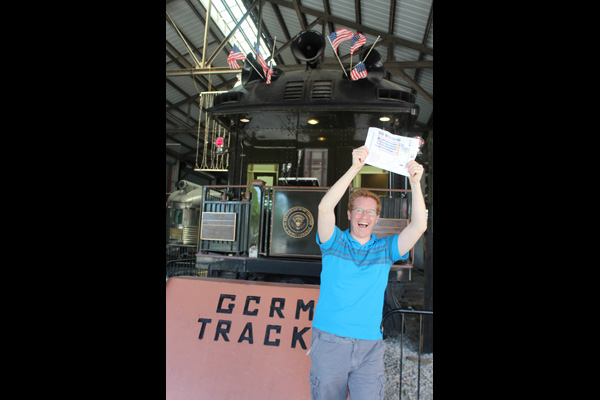
Dorky defeats embarrasment!
Air travel was a thing in the 1940s, but the industry hadn't quite figured out how to make it sexy. It wasn't fun to make out with your secretary when the engine noise was so loud, you'd never hear your wife approaching. You also couldn't have a delightful four-course dinner when random air pockets might launch the hot soup course onto your crotch at any moment. Why, that would make the canoodling even tougher!
No, in the 1940s, if you wanted discreet and sumptuous travel, rail was king. And the president of the United States deserved nothing less than the finest of rail cars. The Pullman Company was a luxury brand -- Abraham Lincoln's son had once been the president of the company! And you could modify a rail car to keep it safe from shadowy German saboteurs.
The Pullman company built six rail cars named after explorers -- although no one every explored anything via railroad -- and the U.S. government acquired the Ferdinand Magellan. It was modified with Nazi-proof armor plating, then put at the disposal of Franklin D. Roosevelt, a guy who knew something about rolling all over the place.
The Ferdinand Magellan served FDR, Harry Truman and Dwight Eisenhower before technological advances forced it into retirement. The government was ready to dump it on the ash heap of history, but the Gold Coast Railroad Museum -- in Miami -- snapped it up in the late 1950s. They have held it ever since, with a brief interlude to lend it to Ronald Reagan for a campaign event in 1984.
I finally got to visit this chariot of the gods in March 2021. (America was shut down, but Florida was open.) The first thing you need to realize about the Ferdinand Magellan: luxury is relative. Even after modifications -- a few bedrooms were converted into social areas -- it's not exactly spacious. The "hallway" between rooms is barely wide enough for my body, shoulder to shoulder -- so imagine the gymnastics required to get a customized FDR wheelchair back and forth. FDR enjoyed a little more personal space in his quarters, because his wife rarely traveled with him and took a separate cabin when she did. But it wasn't exactly the Ritz, and if he wanted to make time with his personal assistant everyone on board definitely would have known about it. He had the room to lay down, read a book, sign a few executive orders and not much else.
The dining room, at least, was the full width of the car. They squeezed in a decent sized dining table and slapped some wood paneling on the walls to class the place up; you could have a very classy dinner for eight, as long as no one was too beefy and everyone could hold their bladders for the course of the meal.
The observation lounge at the far end wasn't too bad, either. You could pal around with cronies or less-ethical journalists while relaxing in relatively comfortable chairs, watching the tracks disappear behind you. Of course, everyone was probably smoking, so the entire Ferdinand Magellan probably smelled like Satan's armpit. They would have been used to it back then, but the mustiness lives on today.
FDR rode about 50,000 miles in the Ferdinand Magellan, with his last trip being a dip down to his vacation home in Warm Springs, Georgia, in the spring of 1945. He used the train briefly when he was a corpse -- it carried his body up to Hyde Park for his funeral -- but they probably don't count that on his mileage totals.
It was Truman, however, that captured my imagination. Every news outlet had written Harry off in 1948, but he never gave up hope. The Magellan was one of his secret weapons, as he crossed the country in a whistlestop campaign and gave hundreds of speeches from the back platform. (It was rigged up with a presidential podium and a decent speaker system for just such occasions.) He was on the Magellan a few days after his victory, when someone handed him a copy of the Chicago Tribune with the famously flubbed headline, "Dewey Defeats Truman." He held it up for the crowds while standing on the back of the Magellan, posing for what is now one of the most famous photos in American history.
The Gold Coast Railroad Museum won't let you stand on the platform, but we got there early enough that they gave us free run of the interior. (The docent hadn't showed up yet.) They also have displays in other cars of past train menus (with a disturbing number of courses) and some info about how many workers it took to make the Magellan run. If you think the president was a little cramped, imagine where they stashed the gaggle of black and Filipino stewards who had to make the whole journey seem effortless.
It's a monument to another era -- and the timeless elegance of rail travel. Chugga chugga choo choo, y'all.
